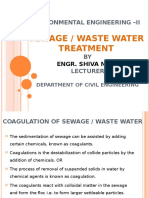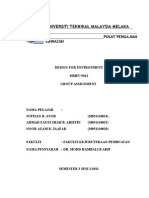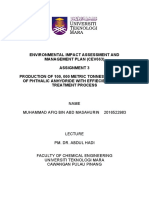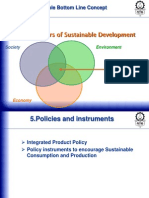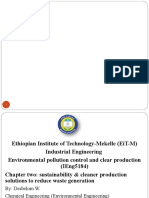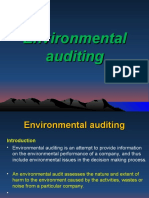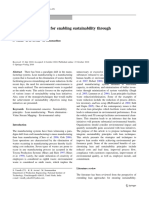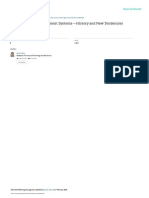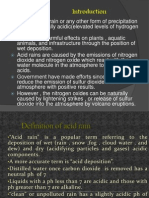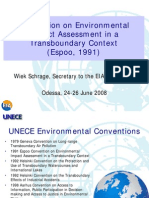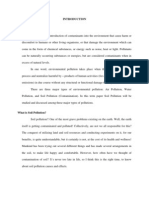Cleaner Production
Cleaner Production
Uploaded by
Luis AjilaOriginal Description:
Copyright
Available Formats
Share this document
Did you find this document useful?
Is this content inappropriate?
Report this DocumentCopyright:
Available Formats
Cleaner Production
Cleaner Production
Uploaded by
Luis AjilaCopyright:
Available Formats
Cleaner Production (CP)
Definition
Cleaner production is defined as the continuous application of a preventive environmental
strategy integrated with processes, products and services to increase overall efficiency
and reduce risks for human beings and the environment. Cleaner production addresses
the saving of raw materials and energy, the elimination of toxic raw materials and the
reduction in quantities and toxicity of waste and emissions, in production processes.
When it comes to development and design of the product, cleaner production addresses
the reduction of negative impacts throughout the life cycle of the product: from the
extraction of the raw material to the disposal of the final product. In term of services,
cleaner production addresses the incorporation of environmental considerations in the
design and delivery of services. In general Cleaner Production is the continuous
application of a preventive strategy and methodology.
Origin
The term Cleaner Production (CP) was launched in 1989 by UNEP and the immediate task
was to create awareness of the concept. In 1999, more than a decade later, the concept of
CP is more viable than ever and has broadened to include products and services in
addition to processes. This means that the diverse actors in the CP field have come to
require different kinds of assistance, and that the ways of promoting CP have evolved as
well. Implementing CP has gone beyond the initial awareness raising activities. [1]
Cleaner Production Project Elements
Development of the diagnosis or initial audit.
Carrying out the necessary measurements and determinations of the variables of
interest.
Identification and evaluation of the appropriate solution alternatives.
Feasibility analysis of the proposed proposals.
Elaboration and application of the general plan of cleaner production.
Feedback of results and decision making for continuous improvement.
Methodology
1. Planning and organization
Obtaining the commitment of senior management.
Organization of the cleanest production team or eco-team.
Establishment of the objectives and indicators of cleaner production.
Identification of strengths, weaknesses, opportunities and threats for cleaner
production
2. Initial diagnosis or audit
Definition of the diagnostic approach, considering technical, economic and
environmental aspects.
Determination of inputs and outputs of materials and energy, in processes.
Elaboration of process flow diagrams
3. Evaluation of the information raised
Realization of material and energy balances.
Identification and evaluation of the causes of excessive consumption and
generation of waste and waste.
Proposal of alternatives (options) for cleaner production.
Preliminary determination of viable alternatives for cleaner production
4. Preparation of feasibility studies
Qualitative preliminary evaluation.
Technical evaluation.
Economic evaluation.
Environmental evaluation.
Selection of the cleanest production alternatives to be implemented.
5. Implementation of cleaner production. The overall cleaner production plan
Preparation of the general cleaner production plan.
Execution of the general plan for cleaner production.
Monitoring the progress of cleaner production in the company.
Standardization and maintenance of cleaner production.
6. Monitoring, feedback and continuous improvement
Implementation of a corporate environmental management system or an
integrated quality, environmental and safety management system, and
incorporation of cleaner production management into it.
Performing audits of the environmental management system or integrated system.
Consolidation of the concept of cleaner production in the organizational culture.
Assurance of feedback and continuous improvement. [2]
Bibliography
[1] UNEP. (s.f.) Industry and Environment. Cleaner Production
[2] Hans D. (2007). Cleaner production and innovation theory. Social experiments as a new model
to engage in cleaner production
You might also like
- Secondary TreatmentDocument14 pagesSecondary TreatmentNasirNo ratings yet
- BSBSUS511 - T2 - Develop Workplace PoliciesDocument13 pagesBSBSUS511 - T2 - Develop Workplace PoliciesJochieng100% (1)
- UL Approved - 360 Pre-Engineered ManualDocument35 pagesUL Approved - 360 Pre-Engineered ManualSierra_RevelesNo ratings yet
- MSDS-PSF-600,000cSt Silicone Damping FluidDocument5 pagesMSDS-PSF-600,000cSt Silicone Damping Fluidvictor.ciprianiNo ratings yet
- Produksi Bersih (Cleaner Production) : TKK 4405 2 SksDocument30 pagesProduksi Bersih (Cleaner Production) : TKK 4405 2 SksDenny Muchammad AnwarNo ratings yet
- C. Cleaner Production C.1. DefinitionDocument3 pagesC. Cleaner Production C.1. DefinitionDianne VillanuevaNo ratings yet
- Module 4 PDFDocument15 pagesModule 4 PDFReizel Ann Madrid SantillaNo ratings yet
- Implementation of Green Manufacturing in Industry - A Case StudyDocument4 pagesImplementation of Green Manufacturing in Industry - A Case StudyreganugrhNo ratings yet
- Guide - Product-Related Environmental Performance Indicators - ENDocument40 pagesGuide - Product-Related Environmental Performance Indicators - ENArmand LiviuNo ratings yet
- Geog 302 Lecture 6 Eia 2014Document16 pagesGeog 302 Lecture 6 Eia 2014Joseph ZotooNo ratings yet
- Green ProductivityDocument4 pagesGreen ProductivityHoneyjhoy AlmazanNo ratings yet
- Cleaner ProductionDocument23 pagesCleaner ProductionSendi Aryadi100% (1)
- Environmental Protection SUPER IMPDocument61 pagesEnvironmental Protection SUPER IMPsharan rajNo ratings yet
- Standard Green Office in Thailand - Journal (Terjemah Bebas)Document13 pagesStandard Green Office in Thailand - Journal (Terjemah Bebas)David DeagerNo ratings yet
- Cleaner Production CompleteDocument39 pagesCleaner Production CompleteAlyssa AdamsNo ratings yet
- Unit 5 Environmental AssessmentDocument12 pagesUnit 5 Environmental AssessmentPruthviraj RathoreNo ratings yet
- DfeDocument25 pagesDfespindus76No ratings yet
- Sustainable Manufacturing DavimDocument20 pagesSustainable Manufacturing DavimtalhawasimNo ratings yet
- Corporate Sustainability PracticesDocument45 pagesCorporate Sustainability PracticesM ManjunathNo ratings yet
- Modeling An Innovative Green Design Method For Sustainable ProductsDocument23 pagesModeling An Innovative Green Design Method For Sustainable ProductsCarolina Bernal RodríguezNo ratings yet
- LDP 613Document127 pagesLDP 613AludahNo ratings yet
- Business Tool For SustainabilityDocument50 pagesBusiness Tool For SustainabilityMarcelino Putra PerdanaNo ratings yet
- LECTURE 2 Corporate Social ResponsibilityDocument25 pagesLECTURE 2 Corporate Social Responsibilityn0195520kNo ratings yet
- Unit 6Document11 pagesUnit 6agrawaltejas947No ratings yet
- CP 1Document21 pagesCP 1zelle monteNo ratings yet
- Environmental Impact AssessmentDocument7 pagesEnvironmental Impact AssessmentLyra Mae PeruchoNo ratings yet
- 2 - Environmental Impact AssessmentDocument8 pages2 - Environmental Impact Assessmentevrian peruchoNo ratings yet
- Development of CP Policies: Approaches and Instruments: Guidelines For The CP CentresDocument97 pagesDevelopment of CP Policies: Approaches and Instruments: Guidelines For The CP CentresGurvinder AroraNo ratings yet
- Factsheet1 Clean ProductionDocument10 pagesFactsheet1 Clean ProductionCharith LiyanageNo ratings yet
- Eco LabelDocument14 pagesEco LabelTrusha HaribhaktiNo ratings yet
- 1-Introduction To Quality and Productivity (General) : Quality in Business, Engineering and Manufacturing Has ADocument10 pages1-Introduction To Quality and Productivity (General) : Quality in Business, Engineering and Manufacturing Has AAnupama SinghNo ratings yet
- Assignment 3 EiaDocument6 pagesAssignment 3 EiaWan ahmad Zahin RizzqiNo ratings yet
- Machining WasteDocument6 pagesMachining Wastegunawan refiadiNo ratings yet
- The Implementation of Environmental Audit in Indonesia (Shella, Dzaki Jenevoa, Rama Putranto)Document12 pagesThe Implementation of Environmental Audit in Indonesia (Shella, Dzaki Jenevoa, Rama Putranto)DZAKI JENEVOA KARTIKA -No ratings yet
- Enviornment Management StrategiesDocument15 pagesEnviornment Management StrategiesVarun JainNo ratings yet
- TLA 10 Answers (Theory)Document3 pagesTLA 10 Answers (Theory)Hayes HareNo ratings yet
- Proposal For An Environmental Management System With Clean ProductionDocument8 pagesProposal For An Environmental Management System With Clean ProductionJoão Pedro Braga TeixeiraNo ratings yet
- Sustainable ProductionDocument24 pagesSustainable ProductionNurrul JannathulNo ratings yet
- Sree Sastha Institute of Engineering and Technology: Green Audit ReportDocument11 pagesSree Sastha Institute of Engineering and Technology: Green Audit ReportCandida DhasonNo ratings yet
- Chapter 9: Environmental Impact Assessment & Environment AuditDocument16 pagesChapter 9: Environmental Impact Assessment & Environment AuditShahmi Mat NawiNo ratings yet
- Cleaner Production-A Move Towards Sustainability: Abhilash Vijayan Charanya Varadarajan University of ToledoDocument18 pagesCleaner Production-A Move Towards Sustainability: Abhilash Vijayan Charanya Varadarajan University of Toledothe scorpion 2500No ratings yet
- Introduction To Cleaner Production (CP) Concepts and PracticeDocument64 pagesIntroduction To Cleaner Production (CP) Concepts and PracticeSrinivasan NeelappanNo ratings yet
- Environment AuditDocument16 pagesEnvironment AuditksbbsNo ratings yet
- Sustainablity and Cleaner Production Solutions To Reduce Waste GenerationDocument58 pagesSustainablity and Cleaner Production Solutions To Reduce Waste GenerationDesbelom Welegebrial HagosNo ratings yet
- EIA ProjectDocument19 pagesEIA ProjectLakshmi Narayan R100% (1)
- Green Technology & Sustainable Development (3160514)Document13 pagesGreen Technology & Sustainable Development (3160514)Parth ShahNo ratings yet
- Waste Management and Pollution ControlDocument18 pagesWaste Management and Pollution Controltrippic2396No ratings yet
- Lecture 2. LCADocument11 pagesLecture 2. LCAParitoshNo ratings yet
- Envi-Sci 1Document10 pagesEnvi-Sci 1Abzde GachoNo ratings yet
- Nature Inspired Design: Strategies Towards SustainabilityDocument21 pagesNature Inspired Design: Strategies Towards SustainabilityEmilio AugustoNo ratings yet
- Dimension of Corporate Accountability Across All Business SectorsDocument22 pagesDimension of Corporate Accountability Across All Business SectorsJayvee M FelipeNo ratings yet
- Life Cycle AssessmentDocument79 pagesLife Cycle AssessmentSekar CahyaningsihNo ratings yet
- Environmental Auditing Its Benefits and CounteranceDocument5 pagesEnvironmental Auditing Its Benefits and CounteranceijsidonlineinfoNo ratings yet
- Implementing A CFH ProgramDocument2 pagesImplementing A CFH ProgramCarolWestinghouseNo ratings yet
- Environmental AuditingDocument26 pagesEnvironmental AuditingJack PNo ratings yet
- Notes EIA - 1705296528Document31 pagesNotes EIA - 1705296528Krishan KumarNo ratings yet
- 18euec010 (Ipp Assignment 2)Document7 pages18euec010 (Ipp Assignment 2)lakshmi09aiswaryaNo ratings yet
- Tools and Techniques For Enabling Sustainability Through LeanDocument11 pagesTools and Techniques For Enabling Sustainability Through LeanRohit WalvekarNo ratings yet
- GR 5 Chapter 21 Auditing Environmental ResponsibilityDocument42 pagesGR 5 Chapter 21 Auditing Environmental ResponsibilityJeric CruzNo ratings yet
- Green Cleaning in Healthcare: Current Practices and Questions For Future ResearchDocument56 pagesGreen Cleaning in Healthcare: Current Practices and Questions For Future ResearchPawan MishraNo ratings yet
- Proposalforan Environmental Management Systemwith Clean ProductionDocument9 pagesProposalforan Environmental Management Systemwith Clean ProductionKatrina Diche DipadNo ratings yet
- Environmental Management Systems History and New TendenciesDocument17 pagesEnvironmental Management Systems History and New TendenciesAderlanio Cardoso100% (1)
- Quantification of Sustainability Indicators in the Food SectorFrom EverandQuantification of Sustainability Indicators in the Food SectorNo ratings yet
- Basel ConventionDocument33 pagesBasel Conventionpratik_raj0810No ratings yet
- Satyam - Proposal For CGWA NOCDocument4 pagesSatyam - Proposal For CGWA NOCmahendra sainiNo ratings yet
- One Earth, Two WorldsDocument33 pagesOne Earth, Two WorldsOxfamNo ratings yet
- 5 Ways To Conserve BiodiversityDocument14 pages5 Ways To Conserve Biodiversityjackie varquezNo ratings yet
- Acid RainDocument18 pagesAcid RaindeffjamwezzstarNo ratings yet
- DPR by Rajkot Primary and Secondary SWMDocument236 pagesDPR by Rajkot Primary and Secondary SWMMohit SharmaNo ratings yet
- AWT - Analyst - Winter2019 012819 SMALL RES PDFDocument76 pagesAWT - Analyst - Winter2019 012819 SMALL RES PDFinejattNo ratings yet
- The Brita Product Company: Submitted By: Submitted ToDocument22 pagesThe Brita Product Company: Submitted By: Submitted ToAnandNo ratings yet
- Misc Odessa Jun08 SchrageDocument22 pagesMisc Odessa Jun08 SchragesambashivaNo ratings yet
- Journal Kimia Organik Bahan LautDocument5 pagesJournal Kimia Organik Bahan Lautkemaal sayyidNo ratings yet
- Chapter 9 - ExercisesDocument2 pagesChapter 9 - Exercisesastra_per_asperaNo ratings yet
- Environmental AwarenessDocument16 pagesEnvironmental AwarenessMarsheil Bawaan100% (2)
- Writing Task 2 Enviroment Date May 24 2016Document3 pagesWriting Task 2 Enviroment Date May 24 2016Jinnie Lam ThảoNo ratings yet
- Be CS G1 Coca-ColaDocument21 pagesBe CS G1 Coca-ColaHammert Runner100% (1)
- Wildlife Resources Conservation and Protection ActDocument7 pagesWildlife Resources Conservation and Protection ActAntonio Salvador100% (1)
- OdmeDocument2 pagesOdmeHotnCrispy CrispyNo ratings yet
- Environmental Aspect & ImpactDocument5 pagesEnvironmental Aspect & ImpactBaran ShafqatNo ratings yet
- AN2VP6HRZ3T6S0HR1816 ETicketDocument3 pagesAN2VP6HRZ3T6S0HR1816 ETicketJINU RAJ K KNo ratings yet
- Eawag Report - ARTI India PDFDocument66 pagesEawag Report - ARTI India PDFJohn TauloNo ratings yet
- Building Design 2 Drainage NotesDocument2 pagesBuilding Design 2 Drainage NotesLemis Sean VerasNo ratings yet
- Soil PollutionDocument21 pagesSoil PollutionAngelo James Ambion0% (1)
- Soprasolar BrochureDocument4 pagesSoprasolar BrochuredrunasNo ratings yet
- Nitrite Test KitDocument2 pagesNitrite Test Kitjohndmariner123No ratings yet
- Tugas Ketiga Bhs Inggris Reading Comprehention SkillsDocument2 pagesTugas Ketiga Bhs Inggris Reading Comprehention SkillsMELYANA_WANTINo ratings yet
- Draft EA Chennai ISWD Dec 8, 2014Document53 pagesDraft EA Chennai ISWD Dec 8, 2014Additya ChoudhharyNo ratings yet
- This Unit Operates On Continuous Basis (At/ Close To) : Large Scale SettlersDocument19 pagesThis Unit Operates On Continuous Basis (At/ Close To) : Large Scale SettlersChemical NITTNo ratings yet
- Implementing Rules and Regulations of Republic Act 9003Document33 pagesImplementing Rules and Regulations of Republic Act 9003Farica Arradaza ZgamboNo ratings yet
